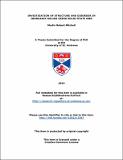Investigation of structure and disorder in inorganic solids using solid-state NMR
Abstract
The use of solid-state NMR and DFT calculations to study Y₂Sn[subscript(x)]Ti[subscript(2-x)]O₇, Y₂Sn[subscript(x)]Zr[subscript(2-x)]O₇ and Y₂Ti[subscript(x)]Zr[subscript(2-x)]O₇, materials with applications for the safe encapsulation of radioactive actinides is investigated. As a result of cation or anion disorder in these materials, NMR spectra are often complex and difficult to interpret. Therefore, an investigation using a range of NMR active nuclei and measurement of a variety of NMR parameters (isotropic chemical shift, δ[subscript(iso)]; span, Ω and quadrupolar coupling, C[subscript(Q)]) were used to provide a full and detailed picture of each material. The measurement of Ω in these disordered compounds with multiple resonances in the NMR spectra, required the use of 2D CSA-amplified PASS (CAPASS) experiments to enable the separation of each of the spinning sideband manifolds. An experimental assessment of the CAPASS experiment showed that although low ν₁/Ω[subscript(Hz)] ratios (as found in ⁸⁹Y NMR) resulted in distortions in the spectra obtained, a modified fitting procedure could be utilised to compensate for this fact, which allowed the accurate measurement of Ω. Despite the difficulties in acquiring the ⁸⁹Y NMR spectra, they were found to be the most informative of the NMR-active nuclei available. ¹¹⁹Sn NMR spectra, although much easier to acquire than ⁸⁹Y, were more complex and harder to analyse, owing to the overlapping resonances. Therefore, ¹¹⁹Sn NMR could only be used to confirm or support the results obtained using ⁸⁹Y NMR. Although ¹⁷O NMR was found to be useful, a full study could not be implemented due to the lack of ¹⁷O enriched samples; an area where future investigation may prove fruitful. Finally, [superscript(47/49)]Ti and ⁹¹Zr NMR spectra were found to be the most difficult to acquire due to their low receptivities and the quadrupolar broadened lineshapes, and as a result, little additional information was obtained.
As a result of this analysis, for the Y₂Sn[subscript(x)]Ti[subscript(2-x)]O₇ pyrochlore solid solution, using primarily ⁸⁹Y δ[subscript(iso)] and Ω, and additionally confirmed with ¹¹⁹Sn δ[subscript(iso)], it was found that the Sn and Ti cations were randomly ordered throughout the B-sites. Additionally, ⁸⁹Y Ω could be used to obtain approximate Y-O[subscript(48f)] and Y-O[subscript(8b)] bond lengths for each type of Y environment. The study of Y₂Sn[subscript(x)]Zr[subscript(2-x)]O₇ using ⁸⁹Y NMR showed that although the end members were single phase, pyrochlore (Y₂Sn₂O₇) or defect fluorite (Y₂Zr₂O₇), the intermediate compositions were mostly two phase mixtures, consisting of an ordered pyrochlore (with an average formula of Y₂Sn₁.₈Zr₀.₂O₇) and a disordered phase, where the proportions of the pyrochlore and disordered phases decreased and increased, respectively, with the Zr content. Additionally, although the coordination states of the Y and Sn cations were easily determined using ⁸⁹Y and ¹¹⁹Sn NMR, respectively, the coordination states of the Zr cations could not be confirmed directly by ⁹¹Zr NMR. However, using indirect analysis from results obtained with ⁸⁹Y and ¹¹⁹Sn NMR, it was determined that 6 coordinate Zr was present in each composition, and it was always present in a greater proportion than 8 coordinate Zr. Finally, although ⁸⁹Y NMR spectra of Y₂Ti[subscript(x)]Zr[subscript(2-x)]O₇ were extremely difficult to analyse, it was tentatively proposed that they could be similar to
Y₂Sn[subscript(x)]Zr[subscript(2-x)]O₇ due to some similarities observed between the spectra.
Type
Thesis, PhD Doctor of Philosophy
Rights
Creative Commons Attribution-NonCommercial-NoDerivs 3.0 Unported
http://creativecommons.org/licenses/by-nc-nd/3.0/
Collections
Except where otherwise noted within the work, this item's licence for re-use is described as Creative Commons Attribution-NonCommercial-NoDerivs 3.0 Unported
Items in the St Andrews Research Repository are protected by copyright, with all rights reserved, unless otherwise indicated.


